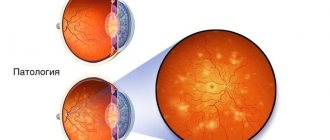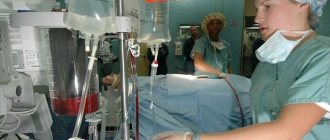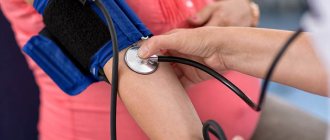Diabetes mellitus is a progressive chronic disease characterized by impaired carbohydrate metabolism. This is manifested by high blood glucose levels and the development of damage to blood vessels and internal organs over time. All over the world, the number of people with diabetes mellitus 1 is steadily growing. For what reasons does this disease occur and what obvious symptoms should be paid attention to, we will analyze in the material.
Causes of diabetes mellitus
Type 2 diabetes mellitus can develop for several reasons. Significant prerequisites for its occurrence are excess nutrition and low physical activity, which leads to obesity 1. Due to the constant accumulation of glucose and lipids, the sensitivity of adipose tissue to insulin decreases. As a result, insulin production increases compensatoryly, and its level in the blood rises. This in turn inhibits the breakdown of fats, and obesity progresses. Gradually, the reserves of beta cells of the pancreas are depleted, and a lack of insulin occurs 2.
In addition, there is a hereditary predisposition to type 2 diabetes mellitus 3. In old age, there is a decrease in muscle and skeletal mass, accumulation of fat, and in addition, insulin secretion by beta cells worsens, which causes impaired glucose tolerance 4.
Diagnostics in our clinic
Diagnosis of hyperglycemia includes taking a medical history, analyzing clinical symptoms and a number of laboratory tests. A blood sugar test is taken in the morning on an empty stomach. In some cases, it becomes necessary to repeat the analysis after a few days to exclude possible stress factors.
In modern medicine, several methods of testing blood for sugar are used:
- rapid test for determining the approximate glucose concentration - can be carried out at home, but does not provide one hundred percent accuracy;
- analysis for glycated hemoglobin - allows you to determine the average glucose level over a certain period of time (1-3 months);
- Glucose tolerance test is a comprehensive study that involves taking blood from a finger prick four times over two hours (on an empty stomach and after taking glucose).
In a healthy person, the glucose level is 3.5-5.5 mmol per liter of blood. An indicator of 6 mmol is considered a prediabetic state. If the glucose concentration exceeds this value, the doctor has reason to diagnose diabetes mellitus.
When performing a glucose tolerance test, a result of up to 7.9 mmol/l is considered as normal. Diabetes mellitus is indicated by a value of over 11 mmol per liter.
Types of diabetes
There are type 1 and type 2 diabetes mellitus 5.
Type 1 diabetes mellitus can appear due to unclear circumstances or be caused by autoimmune causes, when, under certain conditions, one’s own immune cells begin to destroy the pancreatic tissue responsible for the synthesis of insulin. In type 1, the cells that secrete insulin (beta cells) gradually die, against this background the amount of insulin synthesized decreases.
In type 2 diabetes, the number of insulin-secreting cells itself does not change, but tissue insensitivity to the action of insulin and/or its production may develop.
There are also specific types of disease that arise for a specific reason: genetic defects in beta cells and the insulin molecule, acquired diseases of the pancreas, toxic effects of chemicals, drugs, infections, etc.
Separately, women have diabetes mellitus that occurs during pregnancy - gestational diabetes.
What happens to your appearance with diabetes?
Diabetes is a serious disease that affects your health and appearance. If a person’s skin and hair condition has worsened for no apparent reason, the cause may be a carbohydrate metabolism disorder.
A specific sign of diabetes is itching of the skin and mucous membranes, which appears for no apparent reason. Diabetic skin not only itches, but also becomes drier. This is caused by increased fluid loss, disruption of the sweat and sebaceous glands. High blood sugar slows down the healing of skin wounds and reduces local immunity. Damage to small vessels also occurs, causing the skin to lose its elasticity.
Diabetics have an increased risk of infectious skin diseases, diaper rash, and fungal infections. Scratching allows the infection to easily penetrate the skin.
It is worth checking your sugar level if your hair begins to noticeably fall out, or if it becomes thinner and thinner. Since diabetes provokes metabolic disorders, hair immediately reacts to such changes. Diabetics are at risk of experiencing alopecia areata, in which hair falls out completely in certain areas of the scalp. This most often occurs in type 1 diabetes as a consequence of an autoimmune reaction. Experts also cite damage to the blood vessels through which blood and nutrients flow to the hair follicles as a reason for the deterioration of hair with high sugar levels.
Signs and symptoms of diabetes in adults
Listed here are the classic symptoms of diabetes mellitus (DM). Read carefully and listen to your body.
- Constant fatigue.
Constant fatigue reduces a person’s activity and performance, worsening his well-being. If you don’t feel alert even after sleep, you should think about it. - Persistent hunger.
How to distinguish hunger caused by some disease from ordinary hunger not associated with disease? Find out more about this. - Numbness and pain in the legs.
One of the main and most common complications of diabetes is diabetic polyneuropathy. Therefore, when loss of sensation or numbness in the limbs occurs, it is important to understand that this may be a symptom of diabetes. - Intense thirst.
A symptom that cannot be ignored. With the development of diabetes mellitus, a person, experiencing thirst, drinks from 2 to 6 liters (10-30 glasses) of liquid per day. - Frequent urination.
In diabetes, urine volume can reach 10 liters per day. If you notice frequent and excessive urination, this is a reason to consult a doctor for diagnosis. - Blurred vision.
Symptoms of visual impairment in diabetes mellitus may include: gradual deterioration of vision, spots, threads or other shadows “floating” in the field of vision, etc. Find out more about this. - Unexplained weight loss.
If you notice that within a few months you have inexplicably begun to lose weight without a special program, then such weight loss is a reason to consult a doctor, because this may be a symptom of diabetes. - Long-term healing of wounds.
There may be several reasons, and one of them is manifestations of diabetes mellitus. If you begin to notice wounds, scratches, or ulcers that take a long time to heal, do not ignore it.
Expert opinion
Plyukhova Olga Aleksandrovna
Head. Department of Laser Therapy, ophthalmic surgeon of the highest category, Candidate of Medical Sciences
Often, in the presence of the first and second stages of the disease, a person does not notice the manifestations of the disease. Signs of pathology begin to cause discomfort already at the third (proliferative) stage of retinopathy. This is accompanied by deterioration of twilight vision, blurred contours, and distortion of the outlines of objects. Patients with type I or type II diabetes need to be diagnosed by an ophthalmologist at least once every six months.
Disease severity
According to the severity, the disease can be mild, moderate or severe.
.
About light current
they say in the case when no vascular complications are detected. In moderate cases, there are circulatory disorders and associated signs of changes in the organ (retina, kidneys, nerve fibers), which are at an early stage. Severe diabetes mellitus is characterized by chronic pathology of organs and systems with significant impairment of their functions and the formation of clinical diabetic syndromes: heart and kidney failure, condition after stroke and heart attack, loss of vision due to pathology of the retinal vessels, etc.
Currently, the concept of severity of diabetes mellitus is excluded from the diagnosis, because the severity of the condition is determined not by diabetes mellitus itself or the level of sugar/glucose in the blood, but by the presence of complications (early and late) and their severity 5.
Diabetic retinopathy: how to treat it?
Diabetic retinopathy is a serious complication of type 1 and type 2 diabetes mellitus. It can lead to decreased vision and blindness.
Diabetic retinopathy develops with long-term diabetes and affects the retinal vessels (blood vessels of the retina).
Diabetic retinopathy is one of the most severe complications of diabetes mellitus and occurs in 90% of patients. In the initial stages of the disease, a person does not feel any symptoms, and even when the doctor sees severe changes in the fundus, the patient may not experience any discomfort.
But, in patients with diabetes, the risk of complete loss of vision is 25 times higher than in healthy people.
That is why only early treatment, timely diagnosis and subsequent therapy using special equipment are the basis for the prevention of blindness in diabetes mellitus.
- If you are diagnosed with type 1 diabetes, you must be examined by an ophthalmologist at least 2 times a year if you have had the disease for 8-10 years.
- Patients with type 2 diabetes mellitus are examined 2 times a year from the moment of diagnosis.
- Elderly people need more frequent examinations, because... Age-related changes occur in the eyes, which together lead to a significant deterioration in vision.
Only an extremely attentive attitude to your health and a timely visit to an ophthalmologist will help you preserve your vision for as long as possible, even if you have diabetes.
TsLKZiM specialists carry out work on early diagnosis, drug, laser and surgical treatment of complications of diabetes mellitus in the eyes, and also carry out dynamic monitoring of patients with type 1 and type 2 diabetes mellitus.
Today, diabetes mellitus is one of the most common diseases that worsens the daily life of the population and leads to dire consequences. Every 10 seconds on our planet, 1 person dies from complications of diabetes. This disease is no longer an epidemic, but a pandemic.
Blindness in patients with diabetes occurs 25 times more often than in the general population. In the Russian Federation, 8 million people suffer from diabetes - these are only those people who know about their disease.
Often, patients with advanced stages of diabetic retinopathy turn to an ophthalmologist. Type 1 diabetes mellitus affects vision within 5-15 years from the onset of the disease, and type 2 diabetes mellitus sometimes manifests itself with visual symptoms. The ophthalmologist is the first to make a diagnosis and refers the patient to an endocrinologist to confirm the diagnosis and prescribe hypoglycemic therapy.
It is very important to promptly contact an ophthalmologist to prevent vision loss due to this insidious disease.
The goal of our center is early diagnosis and timely treatment of patients with diabetic retinopathy and other ophthalmological complications of diabetes mellitus in the early stages of the disease.
Such opportunities are available thanks to unique diagnostic, laser and surgical equipment, which is in the hands of professionals.
The center has a diagnostic room equipped with optical coherence tomography (OCT), including the function of recording retinal vessels and the optic nerve, ultrasound and electrophysiological equipment.
The laser department is equipped with all modern types of installations, including those operating in gentle micropulse mode. For surgical intervention, there are the most modern and unique laser-assisted installations in the area for replacing the cloudy lens, as well as unique equipment for the treatment of retinal detachment and other pathological changes in the internal media of the eye.
Successful treatment is facilitated by an interdisciplinary approach to patient management, made possible by the presence of an endocrinologist and a therapist on staff.
Working together with these specialists makes it possible to carry out treatment against the background of compensation for the underlying disease (stabilization of carbohydrate metabolism and blood pressure), as well as carry out preventive measures and prescribe timely treatment.
This approach to the treatment and monitoring of patients with diabetes mellitus and its complications on the organ of vision allows us to prevent the disease from progressing to more severe stages, when restoring vision to the patient is an impossible task.
Patients with type 1 diabetes suffer from retinopathy at an early age; in patients with type 2, the disease manifests itself at a later stage.
It is difficult to say exactly when a complication will occur. Each case is individual.
The worsening of diabetes mellitus can be affected by:
• blood glucose level (indicators of hyperglycemia) • arterial hypertension • chronic renal failure • overweight • young age • pregnancy • heredity • smoking
It is possible to avoid serious vision problems due to retinopathy and slow down complications. It is necessary to be regularly examined by a specialist in order to identify signs of the disease in time and prescribe treatment.
Stages of diabetic retinopathy
3 stages of development:
The non-proliferative stage is the background stage. It is diagnosed in diabetics who have been ill for 10-13 years. At this stage, blood vessels become clogged and capillary permeability increases. In the retina, small dilations of blood vessels, edema, exudate (liquid released into the tissue or cavity of the body from small blood vessels during inflammation) and pinpoint hemorrhages in the center or deep tissues of the retina are formed.
The quality of vision at this stage does not change.
The second stage of complications is preproliferative.
At the second stage, vascular anomalies occur and exudate of varying consistency appears. The central zone of the retina is affected (maculopathy).
The third stage is proliferative.
At this stage, the blood supply to certain areas of the retina is disrupted. New blood vessels also appear in the retina or optic disc. Extensive hemorrhages occur and fibrous adhesions and films appear. Retinal detachment and secondary neovascular glaucoma may occur.
Symptoms
Diabetic retinopathy does not appear for very long. A diabetic patient may not even be aware of its progression. Only after some time can a diabetic notice that his vision has decreased in clarity. Therefore, retinopathy is often diagnosed already at the second and third stages of its development. But even at the final stage of the disease, vision can be normal.
Blurred vision, difficulty reading, writing, typing, or working with small parts up close. These symptoms characterize the appearance of edema in the center of the retina.
The patient may also see floating gray or black dense spots, or feel a veil or cobwebs before the eyes. This indicates damage to the blood vessels in the fundus.
With proper treatment, hemorrhages resolve and the spots disappear. But the above symptoms may reappear. This can happen when your glucose levels are unstable or your blood pressure spikes.
Therefore, it is important to monitor these indicators, and if symptoms reappear, immediately contact an ophthalmologist.
Diabetes mellitus can lead to cataracts, secondary glaucoma, hemophthalmos, retinoschisis, retinal detachment and a non-surgical consequence - blindness.
To prevent the development of secondary eye diseases, complex treatment by several specialists is necessary: an ophthalmologist, an endocrinologist, a therapist and a neurologist.
Tatyana Nikolaevna Semenova, the head of the laser department of the Central Clinical Clinical Hospital and Medical Center, tells us more about complications of diabetes mellitus.
How to diagnose diabetic retinopathy?
The specialist makes a diagnosis only after receiving the results of an ophthalmological examination, fundus examination and medical history.
During screening (primary examination) the following is checked:
- acuity and assess the state of peripheral vision - study the anterior segment of the eye (cornea, anterior chamber, lens, conjunctiva and eyelids) - examine the fundus through a dilated pupil - measure intraocular pressure
All patients with diabetes should undergo such a check once a year, even if the patient has no complaints. During pregnancy you need to be checked once per trimester.
Regular examination and examination will help identify diabetic retinopathy in the early stages and prevent complications.
Treatment of diabetic retinopathy
Diabetic retinopathy always appears in patients with severe diabetes.
The goal of treatment is to avoid complications of diabetes and slow the progression of retinopathy. In other words, prevent significant vision loss and disability.
To treat diabetic retinopathy, it is necessary to normalize blood pressure and lipid metabolism. Therefore, the patient is seen by several specialists at once: an endocrinologist, an ophthalmologist, a neurologist and a therapist.
Compensation for diabetes mellitus and normalization of blood sugar levels are also required.
Important: treatment of diabetic retinopathy is impossible without treating the underlying disease.
Today there are 3 stages of treatment for diabetic retinopathy:
1) Medication
• drugs that affect arterial hypertension, diabetic nephropathy and retinopathy • angioretinoprotectors and antioxidants that strengthen the vascular wall and immunity, preventing the formation of microthrombi • drugs that improve blood microcirculation, its viscosity and fluidity • lipid-lowering drugs that normalize lipid metabolism in the body • glucocorticoids: administered into the vitreous to eliminate edema • VEGF inhibitors: injected into the vitreous to prevent or stop the formation of new vessels and to reduce retinal edema in cases of edematous maculopathy
2) Laser coagulation of the retina
Panretinal laser coagulation (PRLC) - application of coagulants to all areas of the retina, avoiding the macular area. It is more often used in the second stage of diabetic retinopathy with large areas of ischemia. Properly performed PRLC in the early stages of proliferation is a fairly effective method of treating diabetic retinopathy and avoids severe complications.
At the same time, the retina’s need for oxygen is reduced and the production of VEGF factors, which promotes the growth of newly formed vessels, is inhibited.
Treatment of diabetic macular edema (DME) is carried out using gentle micropulse techniques.
3) Vitrectomy
In advanced cases, subtotal vitrectomy (almost complete removal of the vitreous body) is performed with removal of the posterior limiting membrane, which is attached around the circumference of the optic nerve head.
Treatment outcome and prevention
The result and further treatment highly depend on timely contact with an ophthalmologist, the stage of diabetic retinopathy and the severity of diabetes mellitus. The most unfavorable outcome of the operation is possible in the 3rd, most advanced stage of diabetic retinopathy. It is at the last stage that complications arise that can lead to severe vision loss and blindness.
To avoid the worst consequences, it is extremely important for a patient with diabetes to monitor the underlying disease and their vision, strictly follow the prescriptions of all treating specialists and undergo regular examinations by an ophthalmologist.
If you feel that your vision has become worse or you have discomfort in your eyes, contact your ophthalmologist immediately.
Consequences and complications
Due to the use of an excessive dose of hypoglycemic drugs, excessive physical activity, and during prolonged fasting, a state of hypoglycemia develops - low blood glucose levels. Symptoms: palpitations, trembling, extreme hunger, sweating, dizziness and loss of consciousness. It is necessary to urgently increase the glucose level, because with its prolonged deficiency, loss of consciousness or even a hypoglycemic coma can develop.
Elevated glucose levels over a long period of time disrupt the structure of small and large vessels. Small vessel lesions most often occur in the kidneys and retina. Pathological changes in large vessels can cause heart attacks, strokes, and the formation of long-term non-healing ulcers, which can lead to loss of limbs 5.
Optic nerve changes in diabetic ophthalmopathy
Diabetic ophthalmopathy can be manifested by the following types of pathological changes in the optic nerve:
— optic atrophy
, which is a concomitant pathology of juvenile diabetes. This pathology is characterized by a progressive decrease in vision, narrowing of the visual field and blanching of the optic discs;
— papillopathy
, which occurs in a state of decompensation of the underlying disease and is characterized by sudden attacks of blurred vision, swelling of the optic disc and corpus luteum.
— anterior and posterior neuropathy of ischemic origin
. This pathology is characterized by such signs as a sharp unilateral decrease in visual acuity, sector loss in the visual field. The outcome of this process is most often partial or complete atrophy of the optic nerve.
Treatment of diabetes
The basis of treatment is to maintain blood glucose levels within target values, taking into account nutrition and physical activity. It is also important to give up smoking and alcohol abuse.
For effective treatment, you need to follow the drug therapy regimen, as well as monitor blood glucose levels. Treatment of type 2 diabetes can be carried out either with the use of tablets or with insulin.
In addition to assessing glucose levels, it is recommended to regularly monitor blood pressure.
It is important to properly care for your feet: maintain hygiene, choose comfortable shoes that fit properly, and regularly have your feet examined by specialists. If skin lesions or ulcers appear in this area, you should immediately seek professional help 6.
#3 Insatiable hunger
Due to disrupted metabolic processes in the body, a person may constantly experience a feeling of hunger, as the cells stop absorbing glucose, which is “fuel” for the cells.
The body has to look for alternative sources of energy. Moreover, even consuming a large amount of food is not able to satiate a person. He is unable to satisfy his hunger, because overeating further increases the blood sugar level.
In such a situation, a visit to the endocrinologist cannot be postponed.
Diet
For type 2 disease with excess weight, it is recommended to reduce caloric intake in order to reduce body weight. We are not talking about strict restrictions (on the contrary, strict diets and fasting are contraindicated), but about the gradual formation of a healthy eating style. To lose weight, you need to limit animal fats and sugars, reduce starchy foods and proteins in the menu. Vegetables rich in fiber can be eaten in unlimited quantities.
It is recommended to supplement the menu with polyunsaturated fatty acids: fish, vegetable oils 7. Dishes are prepared boiled, stewed, baked, or steamed. If possible, meals should be divided into 3-6 meals. Daily salt intake should be reduced to 5-8 g. When using insulin, it is important to calculate the amount of carbohydrates.
Drinking alcohol is harmful to health. In diabetes mellitus, alcoholic beverages can also complicate disease control. In the absence of complications of diabetes and digestive pathology, the maximum permissible dose for men is 2 conventional units per day, for women - 1 conventional unit per day, without daily use (1 conventional unit = 15 g of ethanol or 40 g of strong drinks, or 140 g of wine, or 300 ml beer).
Dosed use of sweeteners is acceptable 8.
How does the time of day affect the absorption of carbohydrates?
Scientists have long noticed that the same product is absorbed differently by the body depending on the time of day. And as it turned out, this is due to the production of hormones, or rather, the predominance of one or another hormone. The fact is that hormones that affect carbohydrate metabolism are produced at a strictly defined time, that is, they have their own daily rhythm. At the same time, some hormones promote the absorption of carbohydrates, while others, on the contrary, suppress this process. And it doesn’t matter what time we wake up or go to bed - hormones do not adapt to us and continue to work in their own way. And, if our nutrition does not coincide with the biological rhythm, then the risk of diabetes increases significantly.
So how can you distribute carbohydrates throughout the day so that your blood sugar doesn't spike? You just need to follow a few simple rules:
- You can indulge in a lot at breakfast The fact is that in the morning, cells absorb glucose least of all due to low sensitivity to insulin. And the culprit is the stress hormone cortisol, which is produced in the early morning hours, helping the body adapt after sleep. But in the future, all sugar not absorbed by cells is converted into a useful supply of energy - glycogen. But! After consuming “medium” and “fast” carbohydrates, a feeling of hunger sets in very quickly. Therefore, if you add protein foods with a sufficient amount of fat to your diet, you will be provided with long-term satiety, and the coming day will allow you to use up all the “eaten” calories. However, for those who are planning a second breakfast (snack), of course, it is better not to overload the first meal with calories.
- At lunch , cortisol still continues to be produced, but in smaller quantities, so you can eat “medium” carbohydrates in the form of side dishes (stewed vegetables, potatoes, cereals, pasta). But it’s better not to eat sweets. Even during the daytime, “long” carbohydrates (salads) and protein foods (meat, fish, poultry) must be present.
- In the evening, insulin replaces cortisol. And all the “fast” and “medium” carbohydrates eaten begin to be instantly absorbed, predisposing to weight gain. Accordingly, the load on the body increases. Therefore, at dinner, it is better to give preference to “long” carbohydrates (fresh vegetables) and protein foods (cottage cheese, kefir, poultry, fish), but with a low fat content.
- Try to your main meal (in terms of calories) either for breakfast or lunch . Eating high-calorie foods in the evening increases the risk of developing diabetes, even in people with ideal body weight. But... a very early breakfast at 4-5 am, as well as a late dinner, can provoke the development of diabetes. In the early morning, the sleep hormone melatonin still continues to be produced, which suppresses insulin production, thereby increasing the risk of developing diabetes. Therefore, if you still have to have breakfast so early, it is better to give preference to dishes high in protein and fat (omelet, boiled eggs, cottage cheese, cheeses, avocado).
- And a little more about sweets: as mentioned earlier, it is preferable to eat “fast” carbohydrates in the morning and in small quantities , and, best of all, after eating foods that contain a large amount of plant fiber . Thanks to “long” carbohydrates, sweets will be absorbed more evenly and without a sharp increase in blood sugar.
- And, lastly, your daily diet should contain such an amount of calories that your body weight remains normal , since with every extra kilogram the risk of developing diabetes increases. If you are still overweight or obese, you should make every effort to lose weight.
Proper nutrition significantly reduces the risk of developing diabetes, but don’t forget about physical activity and quitting smoking!
The Importance of Self-Control
Self-monitoring is regularly self-measuring blood glucose levels and maintaining this level as close as possible to those determined by the doctor. Regular self-monitoring reduces the risk of complications. Glucose level tests are divided into urgent (performed at any time when there is a change in health) and routine (performed daily at a certain time).
Self-monitoring is recommended to be carried out at different times: on an empty stomach, before meals and 1.5 hours after it, before bedtime, before and after physical activity, in case of acute diseases and suspected low glucose levels 8. For the purpose of self-monitoring of glucose, it is recommended to use individual glucometers with setting the target range 5. The frequency of self-monitoring can be determined by the attending physician.








